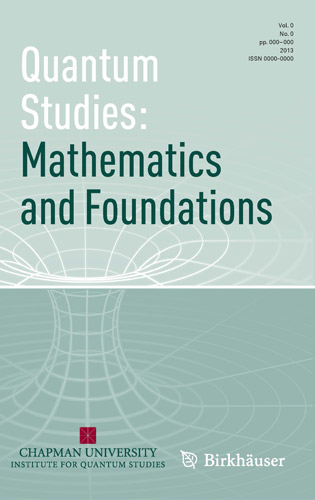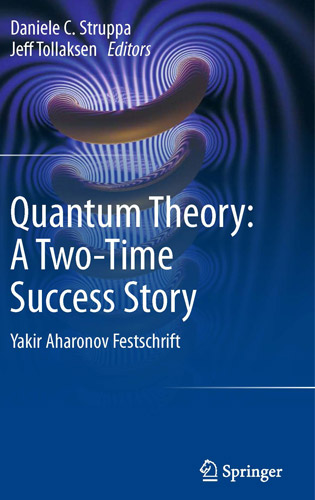- Quantum Studies
- Quantum Conference 2010
- Aharonov, Albert, & Vaidman (AAV) Conference
- About IQS
- Directors
- Affiliated Scholars and Researchers
- Quantum Studies Journal
- Talks with Michael Berry
- Infinite Potential: The Life and Ideas of David Bohm
- Distinguished Visiting Professors in Residence
- Francois Englert, Ph.D.
- Full-Time Faculty and Postdoctoral Fellows
- Institute for Quantum Studies
- IQS Seminar Series
- Quantum Studies Journal
- Popular Material
- Quantum Physics and Logic 2019
- Quantum Simulation and Quantum Walks (QSQW)
- Research Topics
- Published Research
- Yakir Aharonov's Birthday Conference
- Superhydrides and More
- Support IQS
- YA80 Conference
- YA80 Public Event and Discussion
- Videos of the YA80 Conference Talks
- Follow
»Quantum Studies Journal
About Our Journal
 Quantum Studies: Mathematics and Foundations promotes a deeper understanding of all fundamental aspects of quantum theory, bridging
between theoretical questions, foundational issues, mathematical methods and the continuing
evolution of quantum physics.
Quantum Studies: Mathematics and Foundations promotes a deeper understanding of all fundamental aspects of quantum theory, bridging
between theoretical questions, foundational issues, mathematical methods and the continuing
evolution of quantum physics.
Emphasis of QS: M&F is on mathematical methods and insights that lead to better understanding of the paradoxical aspects of quantum physics, and to its expansion into new domains.
This journal benefits physicists, mathematicians and philosophers of science who share an interest in the fundamental aspects of quantum theory.
Call for Papers
You are most welcome to submit your paper for the forthcoming issue of Quantum Studies: Mathematics and Foundations.
Quantum Studies: Mathematics and Foundations primarily aims to promote a deeper understanding of all fundamental aspects of quantum theory. Furthermore, the goal is to help bridge between theoretical questions, foundational issues, mathematical methods, and the further evolution of quantum physics. We publish papers in, and between, these domains.
In addition, we also encourage an emphasis on mathematical methods and insights that lead to a better understanding of the paradoxical aspects of quantum physics and to its expansion into new domains. We encourage the creative use of such paradoxes. This journal includes publication of original papers (research articles and surveys) and invited books reviews.
There is no page limit per manuscript. Naturally, the length of an article should be justified by its content.
Send in your electronic submissions for review using Editorial Manager.
Editorial Board
Editor-in-Chief
Yakir Aharonov
Chapman University
Institute for Quantum Studies
One University Drive
Orange, CA 92866
USA
aharonov@chapman.edu
Managing Editors
Fabrizio Colombo
Politecnico di Milano
Dipartimento di Matematica
fabrizio.colombo@polimi.it
Daniele C. Struppa
Chapman University
Institute for Quantum Studies
struppa@chapman.edu
Jeff Tollaksen
Chapman University
Institute for Quantum Studies
tollakse@chapman.edu
Lev Vaidman
Tel Aviv University
School of Physics and Astronomy
vaidman@post.tau.ac.il
Editorial Board
Daniel Alpay
Ben-Gurion University, Beer-Sheva, Israel
Aharon Casher
Tel Aviv University, Israel
Scott Chapman
Project Hosts, Conneauville, PA, USA
Paul Davies
Arizona State University, Tempe, AZ, USA
Francois Englert
Université Libre de Bruxelles, Belgium
David Gross
UC Santa Barbara, CA, USA
Armen Gulian
Chapman University, Orange, CA, USA
Andrew Jordan
University of Rochester, NY, USA
Takahiro Kawai
Kyoto University, Japan
Anthony Leggett
University of Illinois, Urbana, USA
Shmuel Nussinov
Tel Aviv University, Israel
Philip Pearle
Hamilton College, Clinton, NY, USA
Alex Pines
UC Berkeley, CA, USA
Sandu Popescu
University of Bristol, UK
Leonard Susskind
Stanford University, CA, USA
Bibliographic Information
Quantum Stud.: Math. Found.
1 volume per year, 4 issues per volume
approx. 400 pages per volume
Format: 19.3 x 26 cm
ISSN 2196-5609 (print)
ISSN 2196-5617 (electronic)
Abstracted/Indexed In:
Google Scholar, OCLC, Summon by ProQuest
Quantum Theory: A Two-Time Success Story
 This volume contains 27 original articles contributed by the most celebrated names
in the field of quantum physics, in honor of Yakir Aharonov's 80th birthday.
This volume contains 27 original articles contributed by the most celebrated names
in the field of quantum physics, in honor of Yakir Aharonov's 80th birthday.
Dr. Aharonov is a leading figure in the foundations of quantum physics. His contributions range from the celebrated Aharonov-Bohm effect (1959), to the more recent theory of weak measurements (and whose experimental confirmations were recently ranked as the two most important results of physics in 2011).
Table of Contents
A Century of Quantum Mechanics
David Gross
Realism and the Physical World
Sir Anthony J. Leggett
Each Instant of Time a New Universe
Yakir Aharonov, Sandu Popescu, and Jeff Tollaksen
The Brout-Englert-Higgs Mechanism and Its Scalar Boson
François Englert
NET = T.O.E.?
Shmuel Nussinov
The Limits of Black Hole Complementarity
Leonard Susskind
Quantum Wek Measurements and Cosmology
Paul C.W. Davies
The Quantum Mechanical Arrows of Time
James B. Hartle
Collapse Miscellany
Philip Pearle
Many Worlds, the Born Rule, and Self-Locating Uncertainty
Sean M. Carroll and Charles T. Sebens
Physics and Narrative
David Albert
Quantum Correlations in Newtonian Space and Time
Nicolas Gisin
PR-Box Correlations Have No Classical Limit
Daniel Rohrlich
A Gravitational Aharonov-Bohm Effect, and Its Connection to Parametric Oscillators and Gravitational Radiation
Raymond Y. Chiao, Robert W. Haun, Nader A. Inan, Bong-Soo Kang, Luis A. Martinez, Stephen J. Minter, Gerardo A. Munoz, and Douglas A. Singleton
Paradoxes of the Aharonov-Bohm and the Aharonov-Casher Effects
Lev Vaidman
Weak Values: The Progression from Quantum Foundations to Tool
Andrew N. Jordan and Jeff Tollaksen
Entanglement and Weak Values: A Quantum Miracle Cookbook
Alonso Botero
Weak Energy: Form and Function
Allen D. Parks
Weak Values Beyond Post-selection
Lars M. Johansen
On Superoscillations Longevity: A Windowed Fourier Transform Approach
Yakir Aharonov, F. Colombo, I. Sabadini, D.C. Struppa, and Jeff Tollaksen
Superoscillations, Endfire and Supergain
Sir Michael V. Berry
Relating Local Time Evolutions with Bipartite States: An Exact Map Manifested by Weak Measurements
S. Marcovitch and B. Reznik
Anatomy of Quantum Tunneling
Neil Turok
Experimental Implementations of Quantum Paradoxes
G.A.D. Briggs
Standard and Null Weak Values
Oded Zilberberg, Alessandro Romito, and Yuval Gefen
Increase of Signal-to-Noise Ratio in Weak Measurements
C. Byard, T. Graham, A. Danan, L. Vaidman, A.N. Jordan, and P. Kwiat
Yakir Aharonov: From A to B
A. Pines
Bibliographic Information
Quantum Theory: A Two-Time Success Story
Yakir Aharonov Festschrift
- Editors
- Daniele C. Struppa
- Jeffrey M. Tollaksen
- Publisher
- Springer-Verlag Mailand
- eBook ISBN
- 978-88-470-5217-8
- DOI
- 10.1007/978-88-470-5217-8
- Hardcover ISBN
- 978-88-470-5216-1
- Copyright
- 2014
- Copyright Holder
- Springer-Verlag Italia
- Quantum Studies
- Quantum Conference 2010
- Aharonov, Albert, & Vaidman (AAV) Conference
- About IQS
- Directors
- Affiliated Scholars and Researchers
- Quantum Studies Journal
- Talks with Michael Berry
- Infinite Potential: The Life and Ideas of David Bohm
- Distinguished Visiting Professors in Residence
- Francois Englert, Ph.D.
- Full-Time Faculty and Postdoctoral Fellows
- Institute for Quantum Studies
- IQS Seminar Series
- Quantum Studies Journal
- Popular Material
- Quantum Physics and Logic 2019
- Quantum Simulation and Quantum Walks (QSQW)
- Research Topics
- Published Research
- Yakir Aharonov's Birthday Conference
- Superhydrides and More
- Support IQS
- YA80 Conference
- YA80 Public Event and Discussion
- Videos of the YA80 Conference Talks